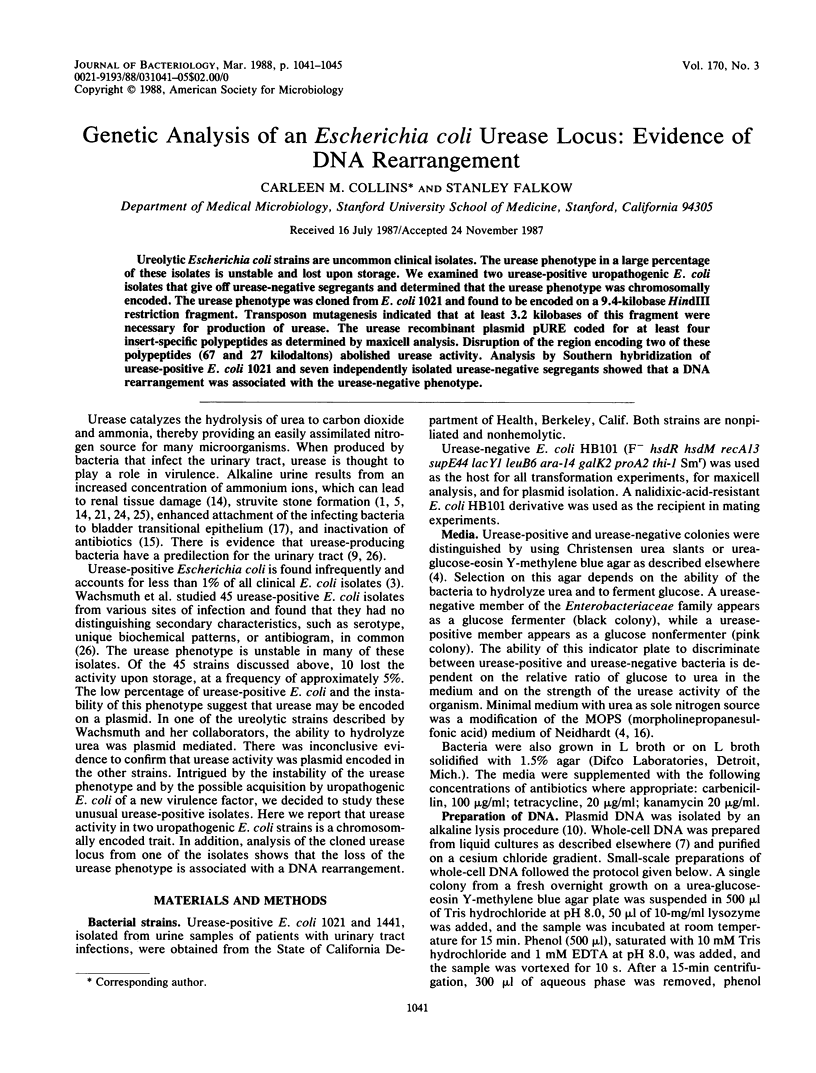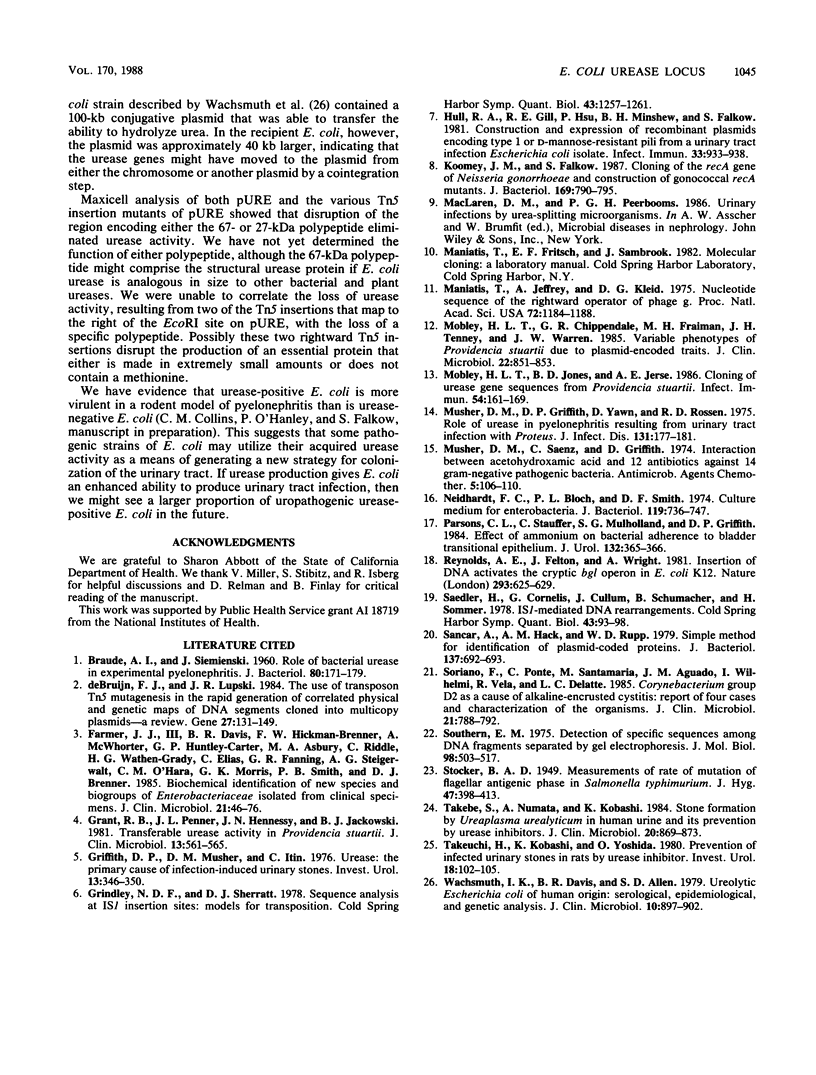Abstract
Ureolytic Escherichia coli strains are uncommon clinical isolates. The urease phenotype in a large percentage of these isolates is unstable and lost upon storage. We examined two urease-positive uropathogenic E. coli isolates that give off urease-negative segregants and determined that the urease phenotype was chromosomally encoded. The urease phenotype was cloned from E. coli 1021 and found to be encoded on a 9.4-kilobase HindIII restriction fragment. Transposon mutagenesis indicated that at least 3.2 kilobases of this fragment were necessary for production of urease. The urease recombinant plasmid pURE coded for at least four insert-specific polypeptides as determined by maxicell analysis. Disruption of the region encoding two of these polypeptides (67 and 27 kilodaltons) abolished urease activity. Analysis by Southern hybridization of urease-positive E. coli 1021 and seven independently isolated urease-negative segregants showed that a DNA rearrangement was associated with the urease-negative phenotype.
Full text
PDF




Images in this article
Selected References
These references are in PubMed. This may not be the complete list of references from this article.
- BRAUDE A. I., SIEMIENSKI J. Role of bacterial urease in experimental pyelonephritis. J Bacteriol. 1960 Aug;80:171–179. doi: 10.1128/jb.80.2.171-179.1960. [DOI] [PMC free article] [PubMed] [Google Scholar]
- Farmer J. J., 3rd, Davis B. R., Hickman-Brenner F. W., McWhorter A., Huntley-Carter G. P., Asbury M. A., Riddle C., Wathen-Grady H. G., Elias C., Fanning G. R. Biochemical identification of new species and biogroups of Enterobacteriaceae isolated from clinical specimens. J Clin Microbiol. 1985 Jan;21(1):46–76. doi: 10.1128/jcm.21.1.46-76.1985. [DOI] [PMC free article] [PubMed] [Google Scholar]
- Grant R. B., Penner J. L., Hennessy J. N., Jackowski B. J. Transferable urease activity in Providencia stuartii. J Clin Microbiol. 1981 Mar;13(3):561–565. doi: 10.1128/jcm.13.3.561-565.1981. [DOI] [PMC free article] [PubMed] [Google Scholar]
- Griffith D. P., Musher D. M., Itin C. Urease. The primary cause of infection-induced urinary stones. Invest Urol. 1976 Mar;13(5):346–350. [PubMed] [Google Scholar]
- Grindley N. D., Sherratt D. J. Sequence analysis at IS1 insertion sites: models for transposition. Cold Spring Harb Symp Quant Biol. 1979;43(Pt 2):1257–1261. doi: 10.1101/sqb.1979.043.01.142. [DOI] [PubMed] [Google Scholar]
- Hull R. A., Gill R. E., Hsu P., Minshew B. H., Falkow S. Construction and expression of recombinant plasmids encoding type 1 or D-mannose-resistant pili from a urinary tract infection Escherichia coli isolate. Infect Immun. 1981 Sep;33(3):933–938. doi: 10.1128/iai.33.3.933-938.1981. [DOI] [PMC free article] [PubMed] [Google Scholar]
- Koomey J. M., Falkow S. Cloning of the recA gene of Neisseria gonorrhoeae and construction of gonococcal recA mutants. J Bacteriol. 1987 Feb;169(2):790–795. doi: 10.1128/jb.169.2.790-795.1987. [DOI] [PMC free article] [PubMed] [Google Scholar]
- Maniatis T., Jeffrey A., Kleid D. G. Nucleotide sequence of the rightward operator of phage lambda. Proc Natl Acad Sci U S A. 1975 Mar;72(3):1184–1188. doi: 10.1073/pnas.72.3.1184. [DOI] [PMC free article] [PubMed] [Google Scholar]
- Mobley H. L., Chippendale G. R., Fraiman M. H., Tenney J. H., Warren J. W. Variable phenotypes of Providencia stuartii due to plasmid-encoded traits. J Clin Microbiol. 1985 Nov;22(5):851–853. doi: 10.1128/jcm.22.5.851-853.1985. [DOI] [PMC free article] [PubMed] [Google Scholar]
- Mobley H. L., Jones B. D., Jerse A. E. Cloning of urease gene sequences from Providencia stuartii. Infect Immun. 1986 Oct;54(1):161–169. doi: 10.1128/iai.54.1.161-169.1986. [DOI] [PMC free article] [PubMed] [Google Scholar]
- Musher D. M., Griffith D. P., Yawn D., Rossen R. D. Role of urease in pyelonephritis resulting from urinary tract infection with Proteus. J Infect Dis. 1975 Feb;131(2):177–181. doi: 10.1093/infdis/131.2.177. [DOI] [PubMed] [Google Scholar]
- Musher D. M., Saenz C., Griffith D. P. Interaction between acetohydroxamic acid and 12 antibiotics against 14 gram-negative pathogenic bacteria. Antimicrob Agents Chemother. 1974 Feb;5(2):106–110. doi: 10.1128/aac.5.2.106. [DOI] [PMC free article] [PubMed] [Google Scholar]
- Neidhardt F. C., Bloch P. L., Smith D. F. Culture medium for enterobacteria. J Bacteriol. 1974 Sep;119(3):736–747. doi: 10.1128/jb.119.3.736-747.1974. [DOI] [PMC free article] [PubMed] [Google Scholar]
- Parsons C. L., Stauffer C., Mulholland S. G., Griffith D. P. Effect of ammonium on bacterial adherence to bladder transitional epithelium. J Urol. 1984 Aug;132(2):365–366. doi: 10.1016/s0022-5347(17)49628-5. [DOI] [PubMed] [Google Scholar]
- Reynolds A. E., Felton J., Wright A. Insertion of DNA activates the cryptic bgl operon in E. coli K12. Nature. 1981 Oct 22;293(5834):625–629. doi: 10.1038/293625a0. [DOI] [PubMed] [Google Scholar]
- Sancar A., Hack A. M., Rupp W. D. Simple method for identification of plasmid-coded proteins. J Bacteriol. 1979 Jan;137(1):692–693. doi: 10.1128/jb.137.1.692-693.1979. [DOI] [PMC free article] [PubMed] [Google Scholar]
- Soriano F., Ponte C., Santamaria M., Aguado J. M., Wilhelmi I., Vela R., Delatte L. C. Corynebacterium group D2 as a cause of alkaline-encrusted cystitis: report of four cases and characterization of the organisms. J Clin Microbiol. 1985 May;21(5):788–792. doi: 10.1128/jcm.21.5.788-792.1985. [DOI] [PMC free article] [PubMed] [Google Scholar]
- Southern E. M. Detection of specific sequences among DNA fragments separated by gel electrophoresis. J Mol Biol. 1975 Nov 5;98(3):503–517. doi: 10.1016/s0022-2836(75)80083-0. [DOI] [PubMed] [Google Scholar]
- Takebe S., Numata A., Kobashi K. Stone formation by Ureaplasma urealyticum in human urine and its prevention by urease inhibitors. J Clin Microbiol. 1984 Nov;20(5):869–873. doi: 10.1128/jcm.20.5.869-873.1984. [DOI] [PMC free article] [PubMed] [Google Scholar]
- Takeuchi H., Kobashi K., Yoshida O. Prevention of infected urinary stones in rats by urease inhibitor: a new hydroxamic acid derivative. Invest Urol. 1980 Sep;18(2):102–105. [PubMed] [Google Scholar]
- Wachsmuth I. K., Davis B. R., Allen S. D. Ureolytic Escherichia coli of human origin: serological, epidemiological, and genetic analysis. J Clin Microbiol. 1979 Dec;10(6):897–902. doi: 10.1128/jcm.10.6.897-902.1979. [DOI] [PMC free article] [PubMed] [Google Scholar]
- de Bruijn F. J., Lupski J. R. The use of transposon Tn5 mutagenesis in the rapid generation of correlated physical and genetic maps of DNA segments cloned into multicopy plasmids--a review. Gene. 1984 Feb;27(2):131–149. doi: 10.1016/0378-1119(84)90135-5. [DOI] [PubMed] [Google Scholar]





